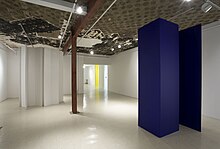Claude Tousignant
Claude Tousignant | |
|---|---|
| Born | December 23, 1932 |
| Education | School of Art and Design at the MBAM |
| Known for | Painter, Sculptor |
| Notable work | "Chromatic accelerator" series |
| Movement | Plasticiens, Tachism |
| Awards | Officer of the Order of Canada Governor General's Award in Visual and Media Arts |
Claude Tousignant OC RCA (born December 23, 1932, in Montreal, Quebec) is a Canadian artist.[1] Tousignant is considered to be an important contributor to the development of geometric abstraction in Canada.[2][3][4] He masterly used alternating values of complementary colours in innovative ways in his circle/target paintings.
Biography
Claude Tousignant was born in Montreal, Quebec.[1] From 1948 to 1951, he attended the School of Art and Design at the Montreal Museum of Fine Arts where he studied under Arthur Lismer, Louis Archambault, Marian Dale Scott, Jacques de Tonnancour and Gordon Webber.[5] He then travelled to Paris where he studied at the Académie Ranson, returning to Montreal in the spring of 1952.[5]
Artistic career

Tousignant is considered a member of the second generation of the modern art movement in Montreal called "les Plasticiens".[6][2] This group of four painters (Jean-Paul Jérôme, Louis Belzile, Rodolphe de Repentigny (Jauran) and Fernand Toupin) felt painting should be pure form and colour; meaning and spontaneous expression were to be avoided.[7] In 1962, Tousignant introduced the form of the circle, which would become his signature motif, into his geometric paintings.[8]
Awards
- Governor General's Award in Visual and Media Arts (2010)[9]
- Paul-Émile Borduas Prize (1989)[10][11]
- Officer of the Order of Canada (1976)[11]
- Victor Martyn Lynch-Staunton Award (1974)[12]
- Prize from the Canadian Institute of Rome (1973)[13][14]
- First prize (painting), Perspective '67, Toronto (1967)[15]
- First prize (painting), Salon de la Jeune Peinture, Paris (1962)[16]
- Member, Royal Canadian Academy of Arts[17]
Museum collections
- Aldrich Contemporary Art Museum, Ridgefield, Connecticut (USA);[18]
- Artothèque de Montréal;[19]
- Art Gallery of Ontario, Toronto;[20]
- Canada Council Art Bank, Ottawa;[21]
- Musée d'art contemporain de Montréal;[22]
- Musée national des beaux-arts du Québec, Quebec City;[23]
- Montreal Museum of Fine Arts;[24]
- National Gallery of Canada, Ottawa;[1]
- Vancouver Art Gallery, British Columbia;
- York University, Toronto
References
- ^ a b c "Claude Tousignant". National Gallery of Canada. Retrieved 11 October 2013.
- ^ a b "Monochrome Crimson, 1981". National Gallery of Canada. Retrieved 12 October 2013.
- ^ Canadian Art. Society for Art Publications. 1964.
- ^ Joan Murray (1 November 1999). Canadian Art in the Twentieth Century. Dundurn. pp. 99–. ISBN 978-1-55488-120-8.
- ^ a b "Claude Tousignant (1932- ) Chronologie" (in French). Musée d'art contemporain de Montréal. Archived from the original on 13 October 2013. Retrieved 12 October 2013.
- ^ Kristina Huneault; Janice Anderson (11 April 2012). Rethinking Professionalism: Women and Art in Canada, 1850-1970. MQUP. pp. 264–. ISBN 978-0-7735-8683-3.
- ^ Reid, Dennis (1973). A Concise History of Canadian Painting. Toronto: Oxford University Press. p. 294. ISBN 0195402065.
Diametrically opposed to the spontaneous expression of the unconscious—replete with associative meaning—as was earlier sought by the Automatistes, the Plasticiens hoped to achieve a precise uncomplicated response to the painted object.
- ^ "note biographique". Perspectives sur Claude Tousignant. Musée d'art Contemporain de Montréal. Retrieved 23 June 2016.
- ^ "Eight remarkable Canadians win Governor General's Awards in Visual and Media Arts from the Canada Council for the Arts". Canada Council. Retrieved 23 June 2016.
- ^ "CLaude Tousignant". Canadian Encyclopedia. Retrieved 23 June 2016.
- ^ a b "Claude Tousignant". Itinerary in Contemporary Art. Archived from the original on 9 August 2016. Retrieved 23 June 2016.
- ^ "Prizes". Canada Council. Retrieved 15 August 2022.
- ^ "PRIZE CANADIAN INSTITUTE ROME [1 fiche]". Termium Plus. Government of Canada. 8 October 2009. Retrieved 23 June 2016.
- ^ James D. Campbell (1995). After Geometry: The Abstract Art of Claude Tousignant. ECW Press. ISBN 978-1-55022-245-6.
- ^ Creative Canada: A Biographical Dictionary of Twentieth-century Creative and Performing Artists. Published. 1972. ISBN 978-0-8020-0196-2.
- ^ Artistes Canadiens: Expositions. Roundstone Council for the Arts. 1973. ISBN 978-0-919656-00-0.
- ^ "Members since 1880". Royal Canadian Academy of Arts. Archived from the original on 26 May 2011. Retrieved 11 September 2013.
- ^ Roger Matuz (1997). Contemporary Canadian artists. Gale Canada. ISBN 978-1-896413-46-4.
- ^ "Claude Tousignant". Artotheque. Archived from the original on 23 September 2015. Retrieved 23 June 2016.
- ^ "The Transformative Power of Art". Art Gallery of Onatario. Retrieved 23 June 2016.
- ^ "Claude Tousignant". Art Bank. Retrieved 23 June 2016.
- ^ "About the Collection". Musée d'art contemporain de Montréal. Retrieved 24 June 2016.
- ^ Musée national des beaux-arts du Québec; Pierre B. Landry (2009). 75 ans chrono: le Musée national des beaux-arts du Québec, 1933-2008. Musée national des beaux-arts du Québec. ISBN 978-2-551-23759-3.
- ^ "Playing Around With a Gong". td.com. Retrieved 24 June 2016.
External links
- perspectives sur Claude Tousignant A retrospective of his work curated by the Musée d'Art Contemporain de Montréal.
